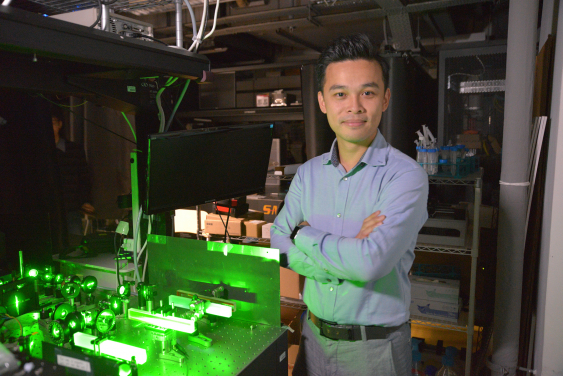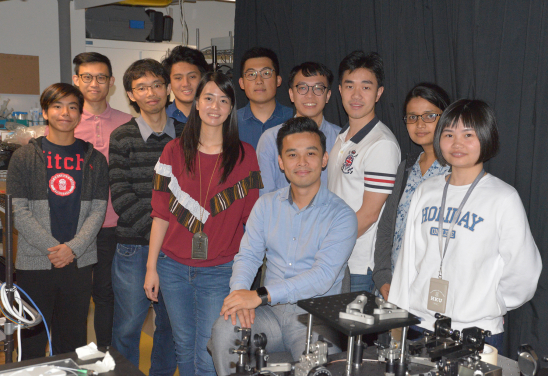Media
HKU and UC Berkeley jointly develop a new type of optical brain imaging platform Engineering scholar awarded over US$2 million funding from the US National Institutes of Health
09 Jun 2019
In collaboration with University of California Berkeley (UC Berkeley), Dr Kevin Tsia, Associate Professor of Department of Electrical and Electronic Engineering and Programme Director of Biomedical Engineering Programme at the University of Hong Kong (HKU) was awarded a funding of over US$2 million from the BRAIN Initiative Fund of the US National Institutes of Health for a project to develop a high-speed optical imaging technology for recording fast neural activity throughout the living animal brain.
Announced by the Obama administration in 2013, the Brain Research through Advancing Innovative Neurotechnologies (BRAIN)® Initiative supports research to develop and to use extraordinary new technologies that will revolutionise our understanding of the brain. Through 2018, the U.S. National Institutes of Health (NIH) invested over US$950 million in the Initiative, supporting over 550 funded awards.
To guide the BRAIN Initiative effort, NIH established a framework in 2014 that outlined several areas of high priority for research funding opportunities. One focused area in particular is “The brain in action”, i.e. to record a dynamic picture of the functioning brain by developing new methods for large-scale monitoring of neural activity.
At the fundamental level, the brain consists of astonishingly complex networks of neurons that are wired together with (synaptic) connections to form what we called neural circuits. In the outer part of the human brain (cerebral cortex) only, there are an estimated 10-20 billions of neurons. Different neurons could show different electrical and chemical activities flowing within these circuits – giving rise to all sorts of different sources of behaviours, e.g. our emotions, perceptions, thoughts, actions, and memories. Therefore, recording signals representing neuronal activities could provide fundamental clues to understand brain functions and more importantly, brain diseases or degeneration.
The classical method is to direct electrical signal readout using electrodes/microelectrodes that are put physically in contact with the brain tissue. It has been the workhorse in neuroscience research to study electrophysiology, yet there are limitations in recording resolution and invasiveness. While this technology continues to improve, optical imaging methods stand out and have revolutionised the field of neuroscience in the past decade. It remains a grand challenge in optical imaging to systematically capture and monitor the motion pictures of these fast neuronal dynamics non-invasively and with single-neuron precision.
The funded NIH project, led by Dr Tsia at HKU and Professor Ji Na at the Department of Physics of UC Berkeley, aims to develop a new type of optical brain imaging platform based on Dr Tsia’s recent invention of an ultrafast laser-scanning imaging technique called FACED. The FACED technique can achieve at least 100 times faster in laser-scanning rate by using a pair of parallel mirrors (“infinity mirror”) to create an ultrafast sweeping laser beam, and can overcome the use of mechanical scanning mirrors and its speed limitation. Dr. Tsia explained, “available optical imaging technologies run short of speed to capture the inherently fast electrical neuronal activities (voltage signals), typically varying in milliseconds or shorter. The ultrafast laser-scanning capability brought by the FACED technique could address the speed challenge in brain imaging.”
Together with UC Berkeley, the research team will leverage on the advanced technique in chemistry and genetics and convert the electrical and chemical activities of individual neurons into light signals which can be easily detected by the optical imaging systems. They will further combine FACED technique with the emerging brain imaging modalities (namely multi-photon imaging) and recent advances in computational sciences to achieve in vivo imaging of neural activities, particularly the voltage activity, throughout the living brain at a frame rate beyond 1,000 frames per second. This is the capability otherwise missing in the current brain imaging technologies. Dr Tsia revealed, “We expect a platform prototype can be established in the coming 3 years and will be employed to augment the capability of current neuroscience technologies and catalyse innovative neuroscience breakthroughs.”
Media enquiries:
Dr Kevin Tsia, Associate Professor, Department of Electrical and Electronic Engineering, HKU (Email: tsia@eee.hku.hk ) or
Ms Celia Lee, Faculty of Engineering, HKU (Tel: 3917 8519; Email: leecelia@hku.hk)



